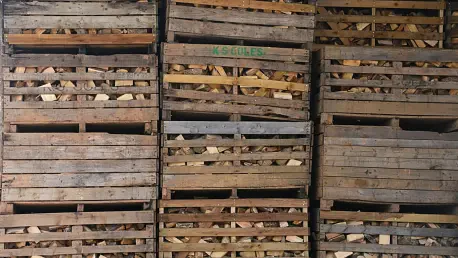The timber industry in the UK stands at a fascinating crossroads as recent data reveals a complex tapestry of declines and growth within the import market, reflecting global supply chain shifts and evolving demands. With construction needs changing, a growing emphasis on sustainability, and intricate economic currents shaping market preferences, the first half of this year has painted a picture of an industry adapting to new challenges and opportunities. Timber imports, a vital lifeline for construction and manufacturing, have experienced subtle yet significant changes. This intricate balance between traditional materials and innovative alternatives is shaping the future of the sector, prompting stakeholders to reassess strategies and priorities. As the numbers unfold, they tell a story of resilience in some areas and vulnerability in others, offering critical insights into how the UK timber market might evolve in the coming months. Delving into these trends provides a window into not just the state of imports, but also the pulse of related industries.
Shifting Volumes and Market Dynamics
The overall volume of timber imports into the UK has seen a marginal decline in the first half of this year, totaling 4.76 million cubic meters, which marks a 2.9% drop compared to the same period last year. This downturn was particularly pronounced in the second quarter, where volumes fell by a notable 159,000 cubic meters, overshadowing a slight uptick of 16,000 cubic meters in the first quarter. Among the major product categories, solid wood imports experienced a more significant reduction of 3.8%, while panel products held relatively steady with a modest 1.2% decline. Softwood imports, a cornerstone of the market, dropped by 4%, with a substantial 10% decrease in shipments from Sweden contributing heavily to this loss, equating to 145,000 cubic meters. However, not all regions followed this trend, as imports from Latvia and Finland rose by 7% and 6% respectively, partially offsetting the deficits with a combined gain of 60,000 cubic meters. These fluctuations highlight the uneven impact of global supply dynamics on the UK market.
Beyond the headline figures, specific segments within the timber import market reveal a nuanced landscape of challenges and resilience. Hardwood imports, despite an encouraging 3% growth in the first quarter, concluded the half-year with a 6% decline due to a weaker second quarter. Medium-density fiberboard (MDF) faced an even steeper fall, plummeting by 29% over the same period. In contrast, certain categories demonstrated remarkable strength, such as engineered wood products (EWP), which surged by 14% in import volume. This growth underscores a rising preference for sustainable and versatile materials in construction and manufacturing. Particleboard and plywood also showed positive movement, with softwood plywood imports increasing by 12.6%, largely driven by supplies from Brazil, which dominates nearly three-quarters of this segment in the UK. These contrasting trends within product categories reflect shifting priorities and the adaptability of the market to emerging needs and supply constraints.
Pricing Pressures and Economic Influences
Pricing volatility has emerged as a significant factor shaping the timber import landscape in the UK during the initial months of this year. Softwood prices, in particular, have spiked by 11%, a surge attributed to tightening supply conditions globally. Within this category, the divergence is stark—whitewood values dipped by 5%, while redwood values soared by an impressive 26%, illustrating the uneven pressures across sub-segments. Plywood, on the other hand, presented a more balanced picture with an overall 2% increase in import value. However, this masks disparities, as hardwood plywood values fell by 2% due to a 12% drop in average prices, despite an 11% rise in volume. Conversely, softwood plywood values climbed by 15%, propelled by a 13% volume increase and a modest 2% uptick in prices. Such pricing dynamics introduce layers of uncertainty for importers and buyers, complicating budgeting and forecasting in an already challenging market environment.
The broader economic context, particularly the state of the UK housing sector, plays a pivotal role in influencing timber demand and import trends. Data from the Office for National Statistics indicates a 23% increase in housing starts in England during the first quarter compared to the same period last year. While this quarterly growth offers a glimmer of optimism, the medium-term outlook remains subdued, with housebuilding activity lingering at historically low levels. This persistent weakness in construction demand directly impacts timber sales and import volumes, creating a ripple effect across the supply chain. Industry experts have pointed out that the lackluster performance in housing construction continues to dampen the market, even as certain timber products gain traction. The interplay between economic indicators and import data underscores the importance of monitoring not just supply and pricing, but also the downstream industries that drive demand for timber in the UK.
Emerging Opportunities in Sustainable Materials
Amid the declines in traditional timber categories, a silver lining appears in the form of engineered wood products, which have captured attention with a 14% increase in import volumes over the first half of this year. This growth signals a broader shift toward sustainable construction materials that offer both versatility and environmental benefits. As the construction industry grapples with stricter regulations and a push for greener building practices, engineered wood stands out as a viable solution, meeting the dual demands of performance and eco-friendliness. Industry voices have highlighted this trend as a reflection of evolving market preferences, where innovation is increasingly prioritized over conventional options. The rise in these products also points to potential shifts in sourcing strategies, as importers seek suppliers capable of meeting the growing demand for such specialized materials in a competitive global landscape.
Further exploration of sustainable materials reveals that the momentum is not limited to engineered wood alone, as certain panel products like particleboard also show promise with incremental gains in import volumes. This trend aligns with the construction sector’s gradual pivot toward materials that reduce environmental impact while maintaining structural integrity. The robust performance of softwood plywood, particularly from dominant suppliers like Brazil, complements this narrative, indicating that sustainability does not come at the expense of volume or availability. However, challenges persist, as imports of similar products from other regions, such as China and Finland, have declined sharply by 20% and 33% respectively. Navigating these disparities requires a keen understanding of global supply chains and the ability to adapt to fluctuating availability. The growing focus on sustainable timber options presents an opportunity for the UK market to redefine its import priorities in alignment with long-term environmental goals.
Reflecting on a Market in Transition
Looking back at the first half of this year, the UK timber import market navigated a period of transition marked by a delicate balance of setbacks and progress. Traditional segments like softwood and hardwood bore the brunt of declining volumes, while innovative categories such as engineered wood products carved out a space for growth. Pricing fluctuations added another layer of complexity, testing the resilience of importers and buyers alike. Despite short-term gains in housing starts, the overarching weakness in construction activity served as a reminder of the broader economic challenges that shaped demand. Moving forward, stakeholders might consider focusing on diversifying supply sources to mitigate regional declines and investing in sustainable materials to align with industry shifts. Exploring partnerships with emerging exporters and prioritizing materials that meet green building standards could position the market for stability. These steps, grounded in the insights from recent data, offer a pathway to adapt and thrive amid ongoing uncertainties.









